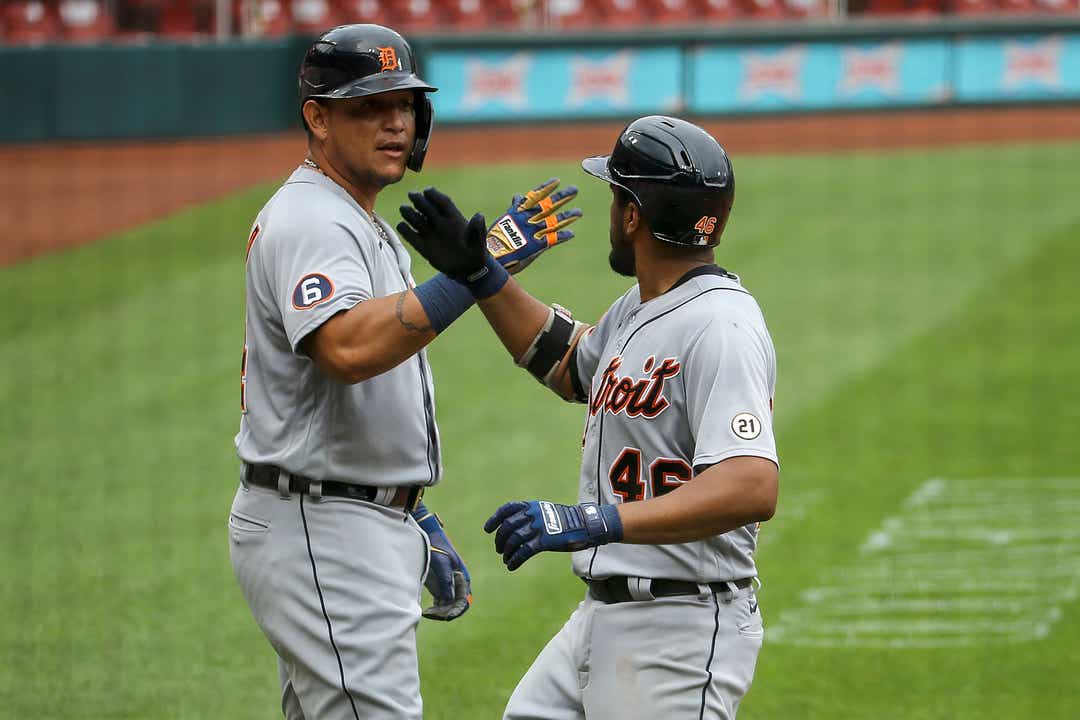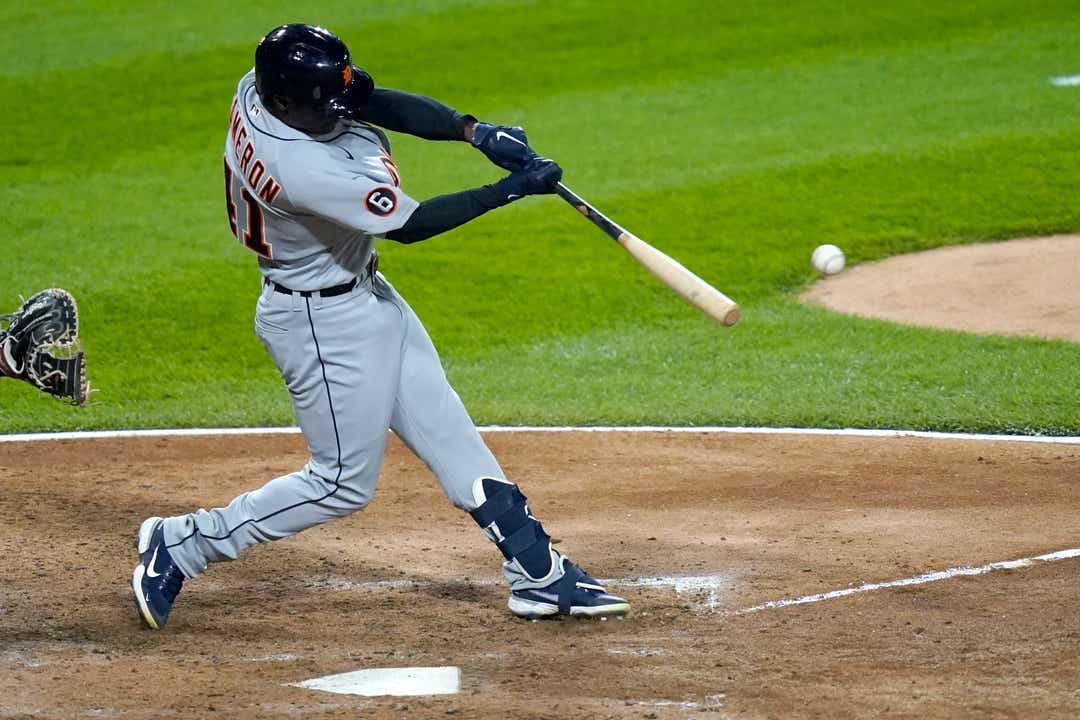Detroit Tigers hitting coach Joe Vavra got his first up-close view of Jeimer Candelario in 2017. At the time, he was the Minnesota Twins’ bench coach.
After the Tigers traded catcher Al Avila and closer Justin Wilson to the Chicago Cubs, Candelario — who came to Detroit in the exchange — became the team’s everyday third baseman. He hit .330 with two homers and 13 RBIs in 27 games.
“He had the ability to use the whole field and looked like a pretty natural hitter,” Vavra said Friday. “I had that in the back of my mind that, if he was once that guy, he could probably get back.”
Vavra joined the Tigers in 2018 as quality control coach, and in each of the past two seasons, Candelario regressed offensively. He was down to a .203 batting average in 2019 and struggled for the first week of the delayed 2020 season, until something clicked in August.
Since his 0-for-17 start in July, though, he has hit .362 with seven homers and 28 RBIs.
[ How Jeimer Candelario went from a concern to carrying team ]

But there was never a “Eureka!” moment. This season, Candelario increased the intensity of his routine. He forced himself to make batting practice feel like in-game scenarios. He stopped talking to the catcher and umpire.
He limited his distractions, and tweaked his approach.
The mechanical changes — starting with his legs — were an attempt to get Candelario back to hitting to all portions of the field. In 2017, he featured a healthy mix of balls pulled (28.9%), hit straight (40.2%) and taken to the opposite field (30.9%). Last season, that had shifted to 43% pulled, 37.6% straight and 19.4% to the opposite field.
“As the years evolved and they challenged him inside, sped him up, slowed him down, he became more of a spin-oriented guy,” Vavra said. “Every team kind of started playing him in the shifts and all that stuff.”
[ Candelario’s secret edge in position battle: Tips from an All-Star ]
Although Candelario, 26, has still struggled this season to drive the ball to the opposite field (18.3%), he has made strides by hitting 43.7% of batted balls to the middle of the field and only pulling at a 38.1% rate.
What also helps is that he is barreling the ball 11.1% of the time he makes contact, a colossal increase from 5.9% last season. (“Barreling” is MLB’s classification for a ball hit with an exit velocity of at least 98 mph, which is likely — depending on its launch angle — to result in a batting average of .500 and a slugging percentage of 1.500.)
That 11.1% ranks 66th in MLB this season; for comparison, MVP favorites Fernando Tatis Jr. and Mike Trout are barreling at 18.8% and 16.3%, respectively.
“That base of his swing is the most important part of it,” Vavra said. “He’s got a real good foundation. It keeps him where he can stay inside the ball batter and really handle the whole plate, especially the outside corner. That’s where guys fail.”

The next step in Candelario’s progression is sustainability.
“If he can keep doing that, maintaining coverage, especially outside coverage and being quick enough inside to understand that he can get that fastball inside without having to look there,” Vavra said, “then he should have a pretty good career going forward.”
Here’s everything else Vavra touched on:
On Willi Castro hitting .347 through 28 games: “He’s comfortable with his setup. He’s quiet with his head, and he doesn’t get too far back in his load. He believes he has the ability to hit any pitch, and that’s a good thing for a young hitter. There’s a lot of guys that know they can’t hit a curveball, know they have trouble with a slider or a changeup. He doesn’t. He’s got 100% accountability. He really trusts his natural ability to hit any pitch. If he’s looking for it, and it’s in the zone, he’s going to put a pretty good swing on it. He’s got good balance. He can use the whole field.”

On challenges of a 60-game season: “I don’t want to use panic, but there’s a little more pressure to get it done in a hurry. Over 162 games over five months plus, you don’t have to get off to a rock-solid start. You have time to recover, and you can kind of transition. That’s beneficial for young guys. The veterans understand that their numbers are going to be where they need to be at the end of the year, so they don’t get into kind of panic mode. Young guys, you bring them along, stay positive: ‘Here’s where you’re at, and here’s where the finish line is. And you’re going to get there. We’ve got 100% belief in you.’ You do that in a 60-game, you try to, but the next thing you know you’re looking at the end of the season coming up, and you don’t have that time to transition. That’s been kind of what’s been happening for the most part, the urgency to get really good right now. Sometimes, they’re not quite there yet.”
On playing the same opponents: “If they’re commanding their pitches and know you chase, they can set you up for failure in a heartbeat. And then, you’re kind of lost. You don’t get that recoup time. We’re playing 10 teams versus (a 162-game season) where you can get a break going to another division and not seeing your own division who you got exploited by for two months. Maybe they said, ‘Oh, he’s made some changes’ and stuff like that. And they might pitch you differently, but you get a little break when you move around to different divisions. Like I said, it’s way different this year, way different.”

On working with MLB newcomers: “It’s a great job. It’s frustrating, but you take the greatness with the frustrating part of it. I don’t like to see kids fail. I like to see them do great things. But you really have to stay positive. You see mechanical flaws, but it’s really hard to transition or get rid of a mechanical flaw when you’re at this point in the season, but you do try to transition and tweak here and there. Most of them, it’s just that — a tweaking. It isn’t a major overhaul. The pitching up here is completely different than anything they’ve seen. It’s more precise. Velocity could be a little higher, but it’s just the ball. They locate the pitch that much better and can set them up. The mind spins. It’s hard to stay with the plan they set out before they got into the batter’s box when one pitch can take them out of their plan. … Their minds just continue turning, and you can’t really slow that down. But you go to work with a positive attitude, have them come in: ‘Here’s what we’re working on. Stay with it.’ Sooner or later, it’s going to win out. But the routine is a very stabilizing part of their game. We’re trying to make it that they understand how to control their mind in the batter’s box in this short period.”
[ Detroit Tigers’ Casey Mize inspired by Indians’ Shane Bieber: ‘That’s the player I can be’ ]
On when prospects will make adjustments: “At the end of this thing, they’re gonna have a sit-down. We’re going to talk about, ‘You’re not hitting this pitch very good, you’re not doing this very good, your recognition’s not good, your plan’s not good.’ Or it’s, ‘Your plan’s great, your pitch recognition is good.’ Give the positive and negatives, and kind of hit them in the face with it, so they have something to go home to understand. Most of them understand their weaknesses, but I also want to make sure that they understand their strengths and can see what their strengths are and not get too carried away with their weaknesses. But let’s conduct a plan that utilizes your strengths a little bit more than worry about your weaknesses all the time. That’s hard for a young kid to do.”

On Austin Romine’s struggles vs. fastballs (13-for-61): “He’s getting the fastball, and he’s fouling them straight back. He’s just not squaring them up. That’s not a timing issue. That’s probably more of a head-movement or body-movement issue. Some of those things he’s trying to deal with, he’s trying to really stabilize the back leg so he doesn’t get too much body into it. He’s a body forward guy, gets on the back leg. Sometimes, he can get over the top of the back leg, which all of a sudden, he’s late to the fastball.”
[ Detroit Tigers still trying to uncover best role for ‘raging bull’ Daniel Norris ]
Harold’s return
The Tigers activated utility player Harold Castro from the 10-day injured list Friday after making room for him by demoting outfielder Travis Demeritte after Thursday’s 10-3 loss to the Indians. He went to the injured list Aug. 19 with a left hamstring strain.
While Castro rehabbed his left hamstring at the alternate training site in Toledo, he had a setback with tightness in his right hamstring. The 26-year-old ran the bases Thursday without any problems, so the organization decided to call him up.

“We need a left-handed hitter, whether it be off the bench or wherever we want to play him at,” manager Ron Gardenhire said. “Multiple positions, infield, outfield. A left-handed hitter on the bench would be a nice thing if we get late (in the) game and run him up there against a righty. There’s multiple options.”
Castro has only taken the field for 15 games in 2020. He has a .276 batting average with three doubles, one RBI, four walks and six strikeouts. He hit .291 with five homers and 38 RBIs in 97 games last season.
Demeritte played 18 games for the Tigers, hitting .172 with four RBIs and three walks and 14 strikeouts in 29 at-bats.
Evan Petzold is a sports reporting intern at the Detroit Free Press. Contact him at epetzold@freepress.com or follow him on Twitter @EvanPetzold. The Free Press has started a new digital subscription model. Here’s how you can gain access to our most exclusive Detroit Tigers content.